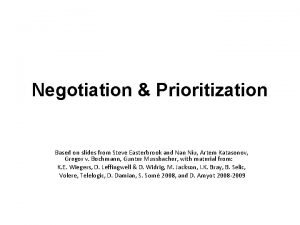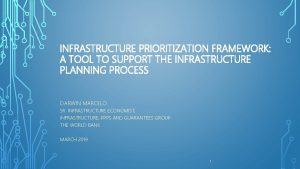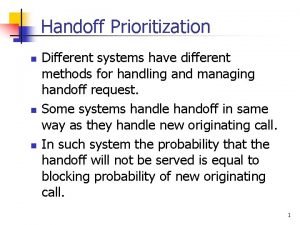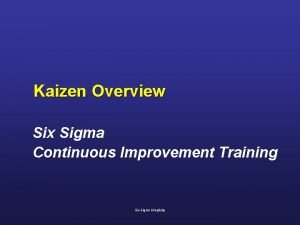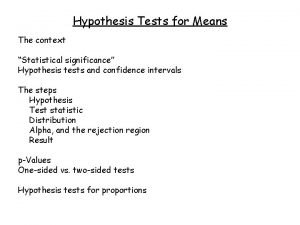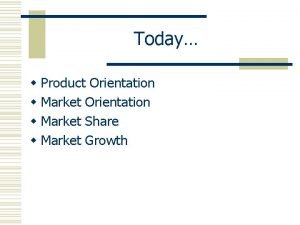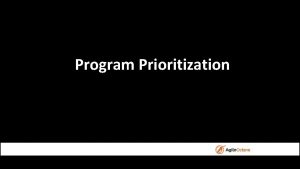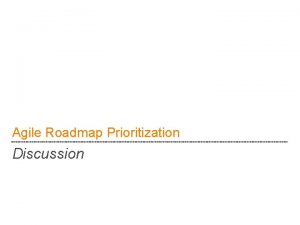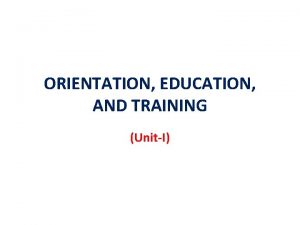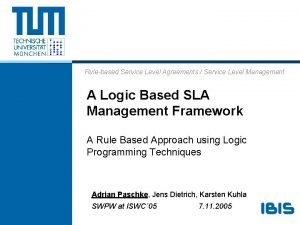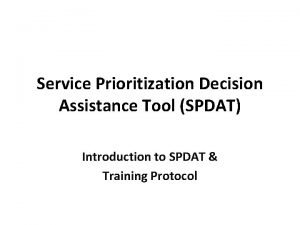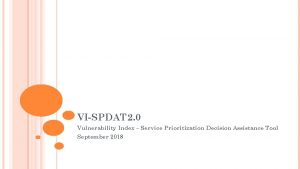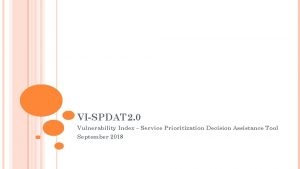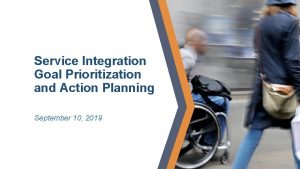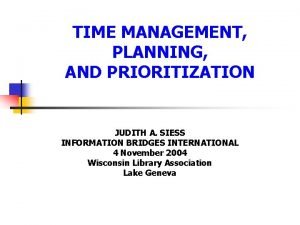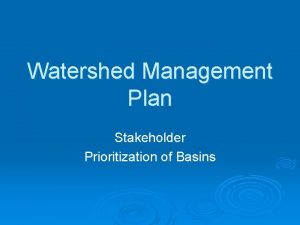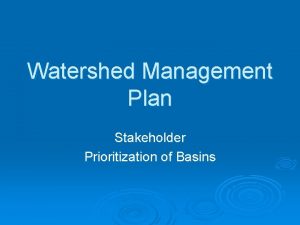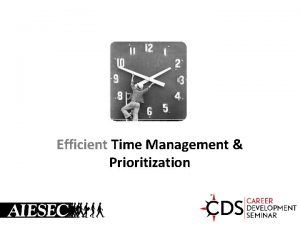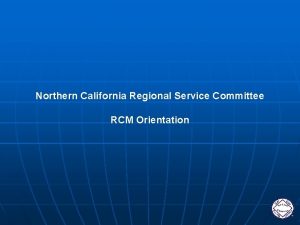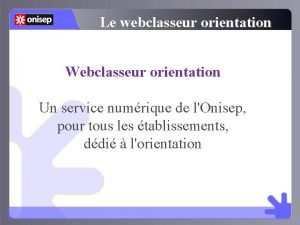Service Level Management Service Orientation Service Level Prioritization




































- Slides: 36

Service Level Management �Service Orientation � Service Level Prioritization Framework � Service Level Agreement � Measurement and Enforcement of Service Levels

SERVICE – DEFINITION Service “Set of predefined processes resulting into output as per the need of stakeholders. ”

SERVICE QUALITY ?

SERVICE QUALITY �Time: time taken for completion of service by the citizen/business, time taken for delivery of service by the Government �Cost: Cost incurred in receiving the service by the citizen/business, cost incurred by the government in delivery of service �Complexity (illustrative): Number of forms to be filled, amount of information to be provided, number of offices to be approached etc by the citizen/business �Transparency: Knowledge on process for delivery of service, delivery timelines, status of service request to citizen and business �Citizen Experience: Quality of interactions (courtesy, politeness, treatment) with the government during service delivery

Service Prioritization Framework �Compile The List of Services �Collect statistics and information about your services �Identify High Value Services which need to be e- Governance-enabled �Prioritize the implementation of the high-value services �Validate and rationalize the results Monday, November 30, 2020 5

Service Prioritization Framework (Step-1) �Compile the list of services Ø Identify the stakeholders served by the department v v First level of classification (citizens, businesses, employees, other governments) Sub-classification (e. g. of citizens of a Education Department) – Parents, Higher education level students, university level students, private college owners… Ø Identification of department functions/services to the stakeholder groups Ø Identification of list of information and transaction services stakeholder wise Monday, November 30, 2020 6

Service Prioritization Framework (Step-2) �Collect statistics about the services Ø Collection of operational information and statistics for the list of services identified in Step 1 Ø Illustrative Information and statistics for each service include: v Transaction volumes v Frequency of transactions v Transaction processing time v Number of customer visits v Time spent by the customer follow-up and track progress Monday, November 30, 2020 7

What adds value to the Department -?

Service Prioritization Framework (Step-3) �Department value measures ØEnhancing existing revenues; ØSetting up new revenue streams; ØReducing cost of processing transactions; ØDelivering intangible benefits (e. g. boosting the image of the department) Monday, November 30, 2020 9

What adds value to the citizens -?

Service Prioritization Framework…. (Step-3) �Citizen value measures Ø Minimizing the number of customer visits Ø Reducing the time required for service Ø Reducing the fees and charges associated with a service; Ø Reducing the time spent by the customer to follow-up and track the progress Ø Reducing the time spent by the customer to file complaints, comments and suggestions Monday, November 30, 2020 11

Service Prioritization Framework(Step-3) Identify high Value Services Value to Citizen Value to Department Monday, November 30, 2020 12

Service Prioritization Framework (Step-3) Identify high Value Services Value to Citizen 2 1 4 3 Value to Department Monday, November 30, 2020 13

Service Prioritization Framework (Step-4) �Prioritize the implementation of the High Value Services Ø Identify when to implement each of the high value services identified for the department Ø The implementation priority for each high value service was defined based on the analysis of service visibility and service complexity Monday, November 30, 2020 14

Service Prioritization Framework (Step-4) Prioritize implementation of the High Value Services…. Service Visibility Service Complexity How significantly and extensively can customers feel and experience the benefits How easy the service can be made E-governance-enabled Services of high volume of transactions and a large customer base Depends on a number of factors e. g. degree of existing automation, number of external parties , number of documents processed Monday, November 30, 2020 15

Service Prioritization Framework (Step-4) Prioritize the implementation of the High Value Services Service Visibility Service Complexity Monday, November 30, 2020 16

Service Prioritization Framework (Step-4) Service Visibility Implement First Implement Third Implement Second Implement Fourth Prioritiz e High Value Services Complexity of Service Monday, November 30, 2020 17

Service Prioritization Framework (Step-4) �Evaluation of potential services based on their criticality and feasibility. Permit Target Defer Pursue Low Criticality Monday, November 30, 2020 High Feasibility Low Feasibility High Criticality 18

Service Prioritization Framework (Step-5) �Validate and Rationalize The Results Ø Identify when to implement each of the high value services identified for the department Ø The implementation priority for each high value service was defined based on the analysis of service visibility and service complexity Monday, November 30, 2020 19

SLA

What is an SLA? An SLA is an agreement - that records the common understanding between the Customer and the Service Provider - about Services, Priorities, Responsibilities, Guarantees and Enforcement mechanism -with the main purpose to agree on the level of service.

PURPOSE OF AN SLA �An SLA is intended to specify performance expectations, responsibilities and metrics. �It ensures all parties have the same understanding of and improves each parties ability to reach intended goals.

KEY REQUIREMENTS �Services and Objectives �Performance Requirements and Responsibilities �Performance Metrics and Measurement �Accountability

SLA �Justification for SLA - Govt is buying services not hardware, software & networks �Specifies quantity & quality of services �Payments – part or full – are linked to performance against SLA �Contains rewards & penalties �Drives the partners – both public & private – to better performance

SLA Lifecycle Service Levels Service Level Measurement System SLOs Business Objectives Services SLA Lifecycle Service Level Mgt SLA

PERFORMANCE METRICS AND MEASUREMENTS Metrics: Should include both minimum and expected performance levels for the service as well as conditions under which the service is considered to be unavailable or limited.

TYPES OF METRICS �Service Availability �Defect Rates �Technical Quality �Security

PERFORMANCE METRICS AND MEASUREMENTS Measurements: Should state how the metrics are going to be monitored, reported and evaluated.

EXERCISE Suggest SLA dimensions in Passport Service from the following perspectives �Citizen �Government �Employee

SLA - CITIZEN PERSPECTIVE • Convenience - choice of time, place & channel • Comfort -layout, ambience, amenities • Quality of Treatment � -responsiveness • Grievance redressal • Transparency -queue management, status tracking)

SLA - Department Perspective • Quality of Service -Error-free • Efficiency • Employee Satisfaction • Security, Availability • Scalability • Support System

SLA - Employee Perspective • Working Conditions -layout -ambience -amenities • Availability (of system) • Response Time (of system) • Support Services

SLA Management : Measurement �“If you can’t measure it, you can’t manage it !” �Tools designed for measuring SLA metric should be precise, reliable, accurate, consistent and trustworthy �Automated measurement by SLA Management System should be used wherever possible �The conditions under which measurement is taken should be defined precisely: �e. g. Measurement of portal page loading: measured over a broadband connection of 128 Kbps �Some SLAs (e. g. user experience) may require periodic surveys and feedback from end users. The methodology for this should be precisely defined in the Contract so as to eliminate later ambiguities and disputes

Challenges in SLA Management �Ensuring SLA data availability �Data integrity �Non measurable parameters – Throughput etc. �Measurement methodology �Coverage of components �Ambiguity of measurement methodology – � one page v/s document �Point of measurement �Specific exemptions (Planned v/s unplanned outage)

Service Level Enforcement - Method by which the service level agreement can be enforced (deduction from payments, penalties etc) Penalties may include: -a percentage of monthly recurring fees that scale up with failure severity. - May be capped and/or cumulative across all SLAs liquidated damages - contract termination for recurring or very severe issues

Dispute Resolution �STEP 1 : Escalation �STEP 2: Mediation �STEP 3: Adjudication/ Expert Determination �STEP 4: Arbitration (prolonged process)
 Project intake process presentation
Project intake process presentation Rpa prioritization matrix
Rpa prioritization matrix Predictive priortization
Predictive priortization Damian2005 trick
Damian2005 trick Problems with wsjf
Problems with wsjf Smart delegation
Smart delegation What is risk management in software engineering
What is risk management in software engineering Abcd prioritization nursing
Abcd prioritization nursing Infrastructure project prioritisation matrix
Infrastructure project prioritisation matrix Prioritization
Prioritization Ticket prioritization
Ticket prioritization Program prioritization process
Program prioritization process Kaizen alternatives
Kaizen alternatives Polycentric management
Polycentric management Orientation level 1 lesson 8
Orientation level 1 lesson 8 A company that succeeds in global marketing
A company that succeeds in global marketing Warren bodo
Warren bodo Top management and middle management
Top management and middle management Top management middle management first line management
Top management middle management first line management Top management middle management first line management
Top management middle management first line management Molecular level vs cellular level
Molecular level vs cellular level Isis level 1 vs level 2
Isis level 1 vs level 2 Dr shaffi
Dr shaffi Isis level 1 vs level 2
Isis level 1 vs level 2 Significance level and confidence level
Significance level and confidence level Confidence level and significance level
Confidence level and significance level Data flow diagram level 1 2 3
Data flow diagram level 1 2 3 Security level 0
Security level 0 Costa's levels of questioning
Costa's levels of questioning Thread-level parallelism
Thread-level parallelism Rcp hlsl
Rcp hlsl Poly foundation programme
Poly foundation programme Mychaffeyview
Mychaffeyview Stony brook orientation
Stony brook orientation Rit mechanical engineering
Rit mechanical engineering Advantages of product orientation
Advantages of product orientation Advantages of product orientation
Advantages of product orientation



